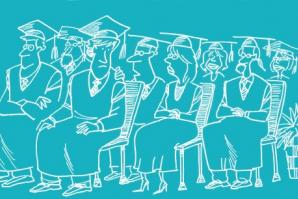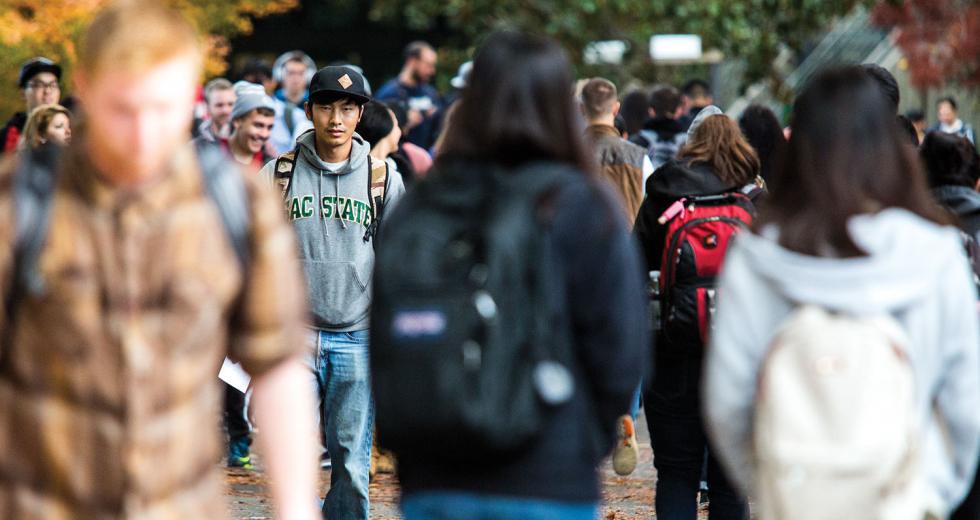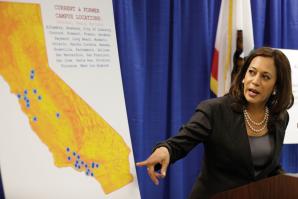Andrea Moon didn’t give a dime to her alma mater. She appreciated her undergraduate experience, but she went to a big institution in the Bay Area, not a place where professors would meet with students after class to discuss assignments or dole out career advice. For those four formative years as an English major, Moon felt anonymous. “I didn’t really know anyone, and nobody knew me,” she says.
But something changed after she entered University of the Pacific’s McGeorge School of Law in Sacramento. Smaller class sizes created an environment that was more supportive, more personal. Faculty and staff knew her name. Her professors had an open-door policy, so students could stop by to chat about classes, internships and the legal education process. All these things inspired Moon to give back. As a student, she joined the student giving program, and since graduating in May 2013, she’s donated monthly to an alumni scholarship that helps students with tuition.
“It’s such an intimate experience, you become invested,” says Moon, now an attorney for the California Prison Authority. “It’s a natural response to want to give back and make sure future students have that same positive experience that you did.”
This is the sort of dream scenario institutions long for. But the reality is, colleges and universities have been struggling to get big donations from graduates in Moon’s generation. Less than half of millennial alumni (individuals born from 1980 to 2000 with a four-year college degree) have written checks to their alma maters, according to research from consulting firm Achieve.
Before you write millennials off as stingy, unappreciative egotists, consider the fact that this group graduated into a dismal economy, saddled with monstrous student loans. Eight of 10 alumni under 35 say the main reason they haven’t donated to their alma maters is that they feel they’ve paid enough already in tuition, according to a 2010 study from Engagement Strategies Group, a New York research firm. Over half also said they “don’t think the school really needs the money,” and they “haven’t been given a good enough reason to give.” Add that to the common belief that their financial gifts end up in some institutional “black hole,” and the bleak donation landscape makes more sense.
But these reasons don’t negate the economic reality: Colleges and universities need that millennial money.
“One-third of our database is young alumni who have graduated in the last 12 years,” says Vince Sales, vice president for university advancement at Sacramento State. “You really have to build a strong affinity with millennials. They have varied interests, and they look at what their peers are doing or at something that may be happening in the local community or internationally that captures their imagination — these things dictate and inform their giving.”
From leveraging social media to launching new programs or resurrecting old ones, institutions in the Sacramento region have initiated several strategies hoping to attract young alumni dollars. Only time will tell if these efforts pay off.
Social Networking
To reach millennials, you have to go where millennials go. In this age, that means online. The University of the Pacific, in Stockton, has been engaging new alumni through Facebook, Instagram and Twitter. The school’s LinkedInU education page, boasting more than 31,000 followers, has proved to be a good way to communicate about reunions and other events. But followers don’t magically amount to funds. Pacific has been leveraging social media to generate buzz around giving by creating a video contest to thank donors. Winners can earn up to $750, and their videos get posted on Facebook.
Sacramento State’s giving program is still primarily phone-based. But Sales also sees new media as a strong tool to promote giving opportunities. Last year, the university participated in Giving Tuesday (the national donation day that follows Cyber Monday), raising $55,000 from alumni in 36 hours, which was matched by the University Foundation at Sacramento State. Organizers used the web and social media to spread the word and cull donations through an online giving platform.
“Older generations would write a check, put a stamp on it and put it in the mail,” Sales says. “But for millennials, technology is the key.”
Beyond the region, Stanford University also uses technology to connect with recent graduates, and its young alumni donor dollars are up year over year, according to Felicity Meu, who specializes in student and young alumni development. Recently, her office created a young-alumni mascot, Stan the Stanford Gnome. On his very own Facebook page, Stan explains that his main responsibility is to thank donors and encourage each new alumni class to give 365 gifts in 365 days.
Says Stan: “Here comes the best part: after you give, I’ll post a personalized Thank You photo on Facebook with your name on it. Just tell me your favorite place on campus and I’ll go there and take my picture with a message to you! It doesn’t matter the size — every gift makes a big difference.
Paper Trail
Around the country, alumni giving plummeted in 2009, primarily due to the recession. But education experts say participation rates have been in decline for years as the result of other noneconomic factors: Donor-advised funds and family foundations (which don’t count as alumni gifts) have grown more popular. And to some millennials, colleges and universities don’t have the same appeal as the latest crowdfunding craze or other charitable causes.
Related: “Donor Behavior” (infographic)
These competing opportunities attest to those fears of the institutional black hole and the fact that millennials want to have a better sense of where their gifts will go. As an example, Sales points to Sacramento State’s homecoming dance marathon. The Student Advancement Council hosted the event and decided to use money earned to set up a student emergency fund. Attendees had to give or raise $25, and the council pulled in about $16,000 from the effort, which Sales says demonstrates that millennials are inclined to support a cause if they know specifically where their donations will end up.
“Older generations would write a check, put a stamp on it and put it in the mail. But for millennials, technology is the key.” Vince Sales, vice president for university advancement, Sacramento State
Similarly, McGeorge boasts a student philanthropy program called “Make Your Mark,” which gives students the chance to give in areas important to them: scholarships, guest speakers, special groups. “When you give to McGeorge, you can earmark your donation to a particular organization or area that really helped you develop within the school,” says Moon, who was active with the federal defender clinic and moot court petition team. “I found that invaluable.”
Old-School Fundraising
But the generation gap between older alumni and millennials doesn’t mean colleges and universities are abandoning more classic fundraising strategies. Sacramento State also has a traditional class gift campaign where graduates give an amount in honor of their class year: 2014 = $20.14. Participants’ names are asterisked in the commencement program, and their tassels have both green and gold (university colors) to recognize their generosity.
Pay in Advance
Overall, the best strategy for colleges and universities seems to be cultivating relationships with millennials before they leave the institution. Arth Patel, a senior biological sciences major at Pacific, is a prime example. He recalls taking college classes in his Minnesota high school and being crammed into lecture halls with some 700 students. But as an undergraduate, the smaller class sizes and personal connections with his professors inspired him to start finding ways to give back early.
As current president of the Pacific chapter of Alpha Chi Sigma, a national chemistry fraternity, Patel led the campaign to raise $10,000 as a gift to the chemistry department. This gift, along with other contributions, will be matched by the $500,000 John Stauffer Challenge to create a $1 million endowment, which will provide about 10 grants every year for undergraduates to pursue summer research opportunities.
“The summer research opportunities weren’t present when I was taking the classes,” Patel says. “I had to take jobs to put myself through school.”
Even after he graduates this spring and goes to dental school, Patel says he will continue to give back. He recognizes that his undergraduate experience and attentive professors shaped his future success. Any member of his generation who feels this way will definitely donate, he says.
“Millennials will give as long as it serves a higher purpose and it’s a good investment for them,” he says. “When the opportunity is presented in the right way, I think our generation is generous.”
Recommended For You

Attention College Shoppers
Graduates' employment data may not tell the whole truth
Workers increasingly need a college degree to survive in today’s complex economy, so as college costs and student loan loads rise, parents and prospective students are asking tougher questions about the results to expect from a baccalaureate. But the answers they’re getting are often inadequate

Renewable Resources
Los Rios prepares to roll out updated student support services
Thomas Hanns was homeless when he first enrolled in classes at Sacramento City College, one of four main campuses that make up the Los Rios Community College District.

Study Abroad
Placer County goes global in search for higher education
A 12-year mission to bring higher education to Placer County, spearheaded by local land baron Angelo Tsakopoulos, has gone global.




